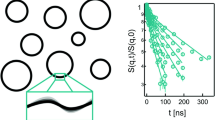Abstract
A procedure is developed to calculate red blood cell and phospholipid vesicle shapes within the bilayer couple model of the membrane. The membrane is assumed to consist of two laterally incompressible leaflets which are in close contact but unconnected. Shapes are determined by minimizing the membrane bending energy at a given volume of a cell (V), given average membrane area (A) and given difference of the areas of two leaflets (ΔA). Different classes of shapes exist in parts of the v/Δa phase diagram, where v and Δa are the volume and the leaflet area difference relative to the sphere with area A. The limiting shapes are composed of sections of spheres with only two values allowed for their radii. Two low energy axisymmetrical classes, which include discocyte and stomatocyte shapes are studied and their phase diagrams are analyzed. For v=0.6, the discocyte is the lowest energy shape, which transforms by decreasing Δa continuously into a stomatocyte. The spontaneous membrane curvature (C 0) and compressibility of membrane leaflest can be incorporated into the model.
A model, where ΔA is free and C 0 determines the shapes at given V and A, is also studied. In this case, by decreasing C 0, a discocyte transforms discontinuously into an almost closed stomatocyte.
Similar content being viewed by others
References
Beck JS (1978) Relations between membrane monolayers in some red cell shape transformations. J Theor Biol 75:487–501
Bütikofer P, Brodbeck U, Ott P (1987) Modulation of erythrocyte vesiculation by amphiphilic drugs. Biochim Biophys Acta 901:291–295
Canham PB (1970) The minimum energy of bending as a possible explanation of the biconcave shape of the human red blood cell. J Theor Biol 26:61–81
Deuling HJ, Helfrich W (1976a) The curvature elasticity of fluid membranes: A catalogue of vesicle shapes. J Phys (Paris) 37:1335–1345
Deuling HJ, Helfrich W (1976b) Red blood cell shapes as explained on the basis of curvature elasticity. Biophys J 16:861–868
Deuticke B (1968) Transformation and restoration of biconcave shape of human erythrocytes induced by amphiphilic agents and changes of ionic environment. Biochim Biophys Acta 163:494–500
Evans EA (1974) Bending resistance and chemically induced moments in membrane bilayers. Biophys J 14:923–931
Evans EA (1980) Minimum energy analysis of membrane deformation applied to pipet aspiration and surface adhesion of red blood cells. Biophys J 30:265–284
Evans EA, Skalak R (1980) Mechanics and thermodynamics of biomembranes. CRC Press, Boca Raton, FL
Helfrich W, Deuling HJ (1975) Some theoretical shapes of red blood cells. J. Phys (Paris) Colloq 36:327–329
Hochmuth RM, Waugh RE (1987) Erythrocyte membrane elasticity and viscosity. Annu Rev Physiol 49:209–219
Jenkins JT (1977) Static equilibrium configurations of a model red blood cell. J Math Biol 4:149–169
Luke JC (1982) A method for the calculation of vesicle shapes. SIAM J Appl Math 42:333–345
Luke JC, Kaplan JI (1979) On theoretical shapes of bilipid vesicles under conditions of increasing membrane area. Biophys J 25:107–111
Peterson MA (1985) An instability of the red blood cell shape. J Appl Phys 57:1739–1742
Sackmann E, Duwe H-P, Engelhardt H (1986) Membrane bending elasticity and its role for shape fluctuations and shape transformations of cells and vesicles. Faraday Discuss Chem Soc 81:281–294
Sheetz MP, Singer SJ (1974) Biological membranes as bilayer couples. A mechanism of drug-erythrocyte interactions. Proc Natl Acad Sci USA 72:4457–4461
Svetina S, Žekš B (1983) Bilayer couple hypothesis of red cell shape transformations and osmotic hemolysis. Biomed Biochim Acta 42:86–90
Svetina S, Žekš B (1984) Red cell membrane properties and the bilayer couple hypothesis of red cell shape transformations. In: Tomicki B, Kuczera J, Przestalski S (eds) Biophysics of membrane transport, part II. Agricultural University Wroclaw, pp 107–126
Svetina S, Žekš B (1985) Bilayer couple as a possible mechanism of biological shape formation. Biomed Biochim Acta 44: 979–986
Svetina S, Ottova-Leitmannova A, Glaser R (1982) Membrane bending energy in relation to bilayer couples concept of red blood cell shape transformations. J Theor Biol 94:13–23
Svetina S, Brumen M, Žekš B (1985) Lipid bilayer elasticity and the bilayer couple interpretation of red cell shape transformations and lysis. Stud Biophys 110:177–184
Svetina S, Brumen M, Žekš B (1988) The role of the membrane elastic properties and cell volume in the formation of red blood cell shapes. In: Benga Gh, Tager JM (eds) Biomembranes: basic and medical research. Springer, Berlin Heidelberg New York, pp 177–187
Zarda PR, Chien S, Skalak R (1977) Elastic deformations of red blood cells. J Biomech 10:211–221
Author information
Authors and Affiliations
Rights and permissions
About this article
Cite this article
Svetina, S., Žekš, B. Membrane bending energy and shape determination of phospholipid vesicles and red blood cells. Eur Biophys J 17, 101–111 (1989). https://doi.org/10.1007/BF00257107
Received:
Accepted:
Published:
Issue Date:
DOI: https://doi.org/10.1007/BF00257107




